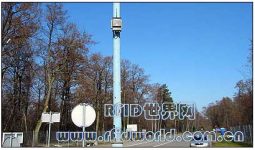
Eastern European countries use RFID electronic seals to successfully improve border cargo transportation security
[ad_1]
The customs authorities of Kazakhstan and Lithuania use RFID electronic seals on trucks passing through the country (most vehicles depart from China, pass through Russia, and arrive in Western Europe) to prevent smuggling and combat theft of goods.
These two countries now use RFID tags, readers and antennas to obtain information about goods and store the data in a database. Two years ago, Kazakhstan’s customs supervision agency began to adopt an automatic transport control system (ADCS) on a small scale. This system includes Hi-G-Tek RFID seals and readers. It was developed by the Lithuanian system integrator Science Technical Center (NTC). Provide software and integration services.

Hi-G-Tek RFID reader at the Nida checkpoint in Lithuania: When a truck passes by a fixed reader installed on a telegraph pole, the vehicle and cargo information will be recorded. At the border channel checkpoint, customs officers then obtain this information from the server in real time, read and write the tags, and check the condition of the goods.
Customs agencies install electronic seals on the cargo doors of incoming trucks (from China to Western Europe) to track the truck’s activities in the country and ensure that the truck has not been opened without authorization. The sensor on the lead seal monitors the status of each lead seal. If any cargo door is found to be opened or damaged, the electronic lead seal will send an alarm signal to the nearest RFID reader, highway or border passage. There is a reader installed.
Every day, about 2,000-3,000 Chinese vehicles pass the Kazakh border or pass through the country on their way to Russia or Western Europe. Every year, goods worth US$2 billion pass through Kazakhstan. In the past, before the vehicle arrived in Russia, the loaded goods were often stolen and appeared on the black market.
The theft of goods has caused the Kazakh government to suffer heavy losses in taxation. Kazakh customs now uses RFID seals to combat such activities, reducing the manual cargo inspection process while improving security. The government hopes that by improving the security of trade routes, Kazakhstan can attract more commercial cargo flows.
The RFID tag in the Hi-G-Tek electronic lead seal transmits signals at two frequencies: 433 MHz for long distances and 125 kHz for short distances. The electronic seal is installed on the handle of the car door, and the memory of the RFID chip is generally 10 kilobytes. When the lead seal is broken, the label in the lead seal sends an alert; in addition, the label can also send other data: such as the identity of the truck and the driver, the type of goods being transported, and sometimes even the entire list of goods.

Hi-G-Tek RFID reader installed at the Lavoriskes checkpoint in Lithuania
When a truck arrives at one of the Kazakh border passages, the staff will inspect the vehicle. After the inspection, the cargo door was closed and an electronic lead seal was added, said Micha Auerbach, founder and technical director of Hi-G-Tek. The staff uses a handheld device provided by Hi-G-Tek to capture the unique ID number of the RFID tag in the lead seal and send the data wirelessly to the organization’s back-end system. NTC data management software enables customs officers to track cargo, store cargo data, and receive timely alerts when electronic seals are damaged.
Customs officers can also use handheld devices to write data into tags, such as the driver’s name and truck ID number, and the date and time of the inspection. After the truck has installed the electronic seals and left the customs, Hi-G-Tek readers (also called outdoor data readers) installed at intervals of 50 kilometers on the highway side obtain tag data along the way.
The fixed reader installed by the highway uses the 433MHZ frequency band to obtain tag data, and then uses the GPRS connection to send the information to the agency’s back-end system. If the lead seal is damaged at any place along the route, the reader of the next vehicle passing by will send an alarm signal to the customs agency. After receiving the alarm information, the customs officer will send local employees to stop the truck. The vast majority of trucks driving westward are from China. When the empty trucks return, the staff also install electronic seals on the trucks to prevent smuggling.
Although Lithuania is much smaller than Kazakhstan, the country is also looking for better ways to ensure that passing trucks are not opened illegally. Lithuania only installs two roadside outdoor RFID readers.
Hi-G-Tek Europe, Middle East and Asia management director Anthony Dublino said that the focus of this system is to electronically seal the truck’s cargo door on the border to ensure that the lead seal is not damaged along the way. After implementing this RFID system 18 months ago, the company has been expanding this system.
The Lithuanian customs authorities use this system in eight border crossings. In Kazakhstan, customs officers use a 125 kHz handheld reader to write data into an RFID tag inside a lead seal.
If a truck stays in the yard of the border passage for a period of time, the motion sensor function in the lead seal will be activated. If anyone attempts to move the cargo door of the truck or drill a hole in it, the sensor will sense it and send an alert to the Hi-G-Tek reader in this area. If a truck looks suspicious, the highway The patrol personnel can stop the car and use a handheld reader to scan the RFID seal to determine the cargo in the truck, the destination and the identity of the driver.
When the truck arrives at the destination, the reader reads the tag again to confirm whether the vehicle has been opened. All data is stored in an Oracle database running INTO software.
[ad_2]



